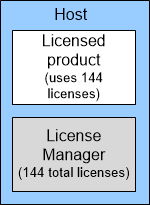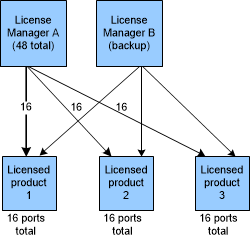Deploying the License Manager
You must install at least one License Manager. For robust availability, you can install more than one (on different hosts). For example, to provide operational backup with a redundant License Manager. In addition:
-
You must load one license file into each License Manager. (If you provide the file during License Manager installation before installing Speech Suite, the Speech Suite installer automatically loads it.)
- If the License Manager and licensed products are on different hosts, you must configure licensing after running the installer. See Setting up licenses.
Using a license manager with an all-in-one deployment
By default Nuance speech products install the License Manager and all licensed components on a single host. This is the minimal, all-in-one configuration:

Using a remote license manager
Alternatively, you can install and run the License Manager on any host in the network so long as it is accessible to all hosts that need it. For example:

When License Manager starts, it creates a pool of licenses (144 in the example). It allocates individual licenses to ports controlled by licensed products on a first-come, first-served basis. License Manager maintains a count of allocated licenses across the network. (When claiming licenses, licensed products exhaust licenses on all configured license managers before returning an error.) The license manager does not monitor port usage on a per-host basis. This allows it to manage licenses on different hosts without knowing the hostid for each host.
Adding security with multiple license managers
Optionally, you can have more than one License Manager. This scenario helps ensure availability to your site: if any license manager fails the others can provide the licenses.
- If you have redundant license managers, Nuance recommends client-configured redundancy, especially for redundancy across a Wide Area Network (WAN). In the FLEXnet documentation, this configuration is called "server redundancy via file list."
- You must decide which license managers are backups and the number of licenses they provide.
- Products get all their licenses from a single, primary license manager, but because they point to all license managers (see Pointing products to a remote license manager), they can change to a backup when failures occur.
In the following example, the license products get licenses from license manager A. If that manager becomes inaccessible, they get licenses from B.

Note: Avoid having more than 3 license managers for each licensed product host. Otherwise, it becomes difficult to troubleshoot problems.
Using quorum redundancy
The quorum configuration is an alternative to client-configured redundancy. It uses three license managers on different hosts to share a single license pool known as a quorum.
Note: Do not use this configuration to distribute license managers across a WAN if there is a risk of network interruptions or delays of heartbeat messages can might interrupt the licensing service.
- Each license manager in the quorum must be on a separate host running the same operating system.
- All license managers load the same license file.
- The entire license pool remains available as long as a quorum of two of the original three license managers are available.
For example:

Note: Configure the primary License Manager on a host that is not running a licensed product. (You can run other processes on that host, but be aware that they reduce the available memory and CPU cycles, and that their failure could affect the functioning of the primary license manager.)
Any three hosts can be formed into a quorum:
- When obtaining the license file from the fulfillment website, enter the hostid for all three hosts. In the illustration, the quorum is consists of hosts 1, 2, and 3 for a total of 48 ports.
- The size of the license pool is determined by the number of licenses available and not the sum of licenses for all three servers.
- When configuring the License Manager list, enter the three hosts in the same order as in the license file.
For example, if your quorum hostnames are LicenseManager1, LicenseManager2, and LicenseManager3, and this is their order in the license file, then they appear like the following port:hostname pairs in the License Manager list:
28000@LicenseManager1:28000@LicenseManager2:28000@LicenseManager3
Note: The colon delimiter is for Linux. Use a semi colon (;) for Windows.
Above, the order of the entries is critical. 28000 is the port used to communicate with the license managers. (Typically, the default port for a single license manager is 27000, and the default for the quorum is 28000.) To change the port, see Changing the license manager port.
How License Managers recover from failures
Licensed products and license managers periodically communicate via a "heartbeat" mechanism. Recognizer, Vocalizer, and Natural Language Engine send a heartbeat message to the License Managers every 30 seconds, while Krypton and Nuance Text Processing Engine send a message every 60 seconds.
If Nuance Recognizer or Nuance Vocalizer for Enterprise suddenly lose communication with their license manager, they continue processing normally for a period of one day and attempt to reconnect during this time. If the server returns during that period, operation continues normally. If these licensed products fail to reconnect, please contact Nuance Network at Nuance Network.
Related topics
Related tasks
Pointing products to a remote license manager
Changing the license manager port
Starting and stopping License Manager
Related parameters
Related topics
